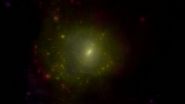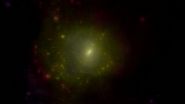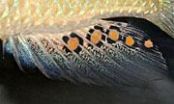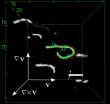Dark matter half what we thought, say scientists
2014-10-09
(Press-News.org) A new measurement of dark matter in the Milky Way has revealed there is half as much of the mysterious substance as previously thought.
Australian astronomers used a method developed almost 100 years ago to discover that the weight of dark matter in our own galaxy is 800 000 000 000 (or 8 x 1011) times the mass of the Sun.
They probed the edge of the Milky Way, looking closely, for the first time, at the fringes of the galaxy about 5 million billion kilometres from Earth.
Astrophysicist Dr Prajwal Kafle, from The University of Western Australia node of the International Centre for Radio Astronomy Research, said we have known for a while that most of the Universe is hidden.
"Stars, dust, you and me, all the things that we see, only make up about 4 per cent of the entire Universe," he said.
"About 25 per cent is dark matter and the rest is dark energy."
Dr Kafle, who is originally from Nepal, was able to measure the mass of the dark matter in the Milky Way by studying the speed of stars throughout the galaxy, including the edges, which had never been studied to this detail before.
He used a robust technique developed by British astronomer James Jeans in 1915 — decades before the discovery of dark matter.
Dr Kafle's measurement helps to solve a mystery that has been haunting theorists for almost two decades.
"The current idea of galaxy formation and evolution, called the Lambda Cold Dark Matter theory, predicts that there should be a handful of big satellite galaxies around the Milky Way that are visible with the naked eye, but we don't see that," Dr Kafle said.
"When you use our measurement of the mass of the dark matter the theory predicts that there should only be three satellite galaxies out there, which is exactly what we see; the Large Magellanic Cloud, the Small Magellanic Cloud and the Sagittarius Dwarf Galaxy."
University of Sydney astrophysicist Professor Geraint Lewis, who was also involved in the research, said the missing satellite problem had been "a thorn in the cosmological side for almost 15 years."
"Dr Kafle's work has shown that it might not be as bad as everyone thought, although there are still problems to overcome," he said.
The study also presented a holistic model of the Milky Way, which allowed the scientists to measure several interesting things such as the speed required to leave the galaxy.
"Be prepared to hit 550 kilometres per second if you want to escape the gravitational clutches of our galaxy," Dr Kafle said.
VIDEO:
This animation shows a supercomputer simulation of a galaxy like the Milky Way and its invisible dark matter halo. We zoom in to the galaxy and can see knots of...
Click here for more information.
"A rocket launched from Earth needs just 11 kilometres per second to leave its surface, which is already about 300 times faster than the maximum Australian speed limit in a car!"
INFORMATION:
Further Information:
ICRAR is a joint venture between Curtin University and The University of Western Australia with support and funding from the State Government of Western Australia.
Dr Prajwal Kafle conducted this research at both the University of Sydney and the International Centre for Radio Astronomy Research at The University of Western Australia.
Original publication details:
'On the Shoulders of Giants: Properties of the Stellar Halo and the Milky Way Mass Distribution' P. R. Kafle, S. Sharma, G. F. Lewis, and J. Bland-Hawthorn. Published in the Astrophysical Journal October 10th, 2014. Available at: http://iopscience.iop.org/0004-637X/794/1/59/
Pre-print paper available at: http://arxiv.org/abs/1408.1787
Contacts:
Dr Prajwal Kafle
ICRAR - UWA
Ph: +61 8 6488 7203
E: prajwal.kafle@icrar.org
Kirsten Gottschalk
Media Contact, ICRAR
Ph: +61 8 6488 7771
M: +61 438 361 876
E: kirsten.gottschalk@icrar.org
UWA Media Office
Ph: +61 8 6488 7977
ELSE PRESS RELEASES FROM THIS DATE:
2014-10-09
PITTSBURGH, Oct. 9, 2014 – National guidelines for the cleaning of certain gastrointestinal (GI) scopes are likely to be updated due to findings from UPMC's infection prevention team.
The research and updated disinfection technique will be shared Saturday in Philadelphia at ID Week 2014, an annual meeting of health professionals in infectious disease fields.
"Patient safety is our top priority," said senior author Carlene Muto, M.D., M.S., director of infection prevention at UPMC Presbyterian Hospital. "We are confident that the change from disinfection to sterilization ...
2014-10-09
PITTSBURGH, Oct. 9, 2014 – UPMC Presbyterian Hospital's infection prevention teams have improved hand washing and sanitizing compliance at the hospital to nearly 100 percent among clinical staff through accountability and educational measures. In a separate effort at UPMC Mercy Hospital, rates of a deadly infection were reduced by educating patients about hand hygiene.
The successful techniques will be reported Saturday in presentations in Philadelphia at ID Week 2014, an annual meeting of health professionals in infectious disease fields.
"Hand hygiene compliance ...
2014-10-09
No matter what type of chemotherapy you attack a tumor with, many cancer cells resort to the same survival tactic: They start eating themselves.
Scientists at Brigham Young University discovered the two proteins that pair up and switch on this process – known as autophagy.
"This gives us a therapeutic avenue to target autophagy in tumors," said Josh Andersen, a BYU chemistry professor. "The idea would be to make tumors more chemo-sensitive. You could target these proteins and the mechanism of this switch to block autophagy, which would allow for lower doses of ...
2014-10-09
The evolution of new traits with novel functions has always posed a challenge to evolutionary biology. Studying the color markings of cichlid fish, Swiss scientists were now able to show what triggered these evolutionary innovations, namely: a mobile genetic element in the regulatory region of a color gene. Their results have been published in the latest issue of the renowned scientific journal Nature Communications.
Biological evolution is in general based on the progressive adaption of traits through natural or sexual selection. However, ever so often, complex traits ...
2014-10-09
Ebola, as with many emerging infections, is likely to have arisen due to man's interaction with wild animals – most likely the practice of hunting and eating wild meat known as 'bushmeat'. A team of researchers led by the University of Cambridge and the Zoological Society of London (ZSL) has surveyed almost six hundred people across southern Ghana to find out what drives consumption of bat bushmeat – and how people perceive the risks associated with the practice.
The Straw-Coloured Fruit Bat, Eidolon helvum, is widely hunted and eaten in Ghana, but carries ...
2014-10-09
Carbon capture is a process by which waste carbon dioxide (CO2) released by factories and power plants is collected and stored away, in order to reduce global carbon emissions. There are two major ways of carbon capture today, one using powder-like solid materials which "stick" to CO2, and one using liquids that absorb it. Despite their potential environmental and energy benefits, current carbon capture strategies are prohibitive because of engineering demands, cost and overall energy-efficiency. Collaborating scientists from EPFL, UC Berkley and Beijing have combined carbon-capturing ...
2014-10-09
Jülich, Germany, 9 October 2014 – When a basically sturdy material becomes soft and spongy, one usually suspects that it has been damaged in some way. But this is not always the case, especially when it comes to complex fluids and biological cells. By looking at the microscopic building blocks – known as "filaments" – of biopolymer networks, researchers from Forschungszentrum Jülich, Germany and the FOM Institute AMOLF in the Netherlands, revealed that such materials soften by undergoing a transition from an entangled spaghetti of filaments to ...
2014-10-09
Some 340 European scientists, policy-makers and other experts representing 143 organizations from 31 countries spoke with one voice today, publishing a common vision of today's most pressing marine-related health and economic threats and opportunities.
In a declaration concluding a three day meeting in Rome, EurOcean 2014 participants also released an agreed, five-year roadmap to achieve expanded, more integrated and effective policy-oriented ocean scrutiny.
EurOcean 2014 was convened by the Italian Presidency of the Council of the European Union, the European Marine ...
2014-10-09
Nyon, Switzerland (October 9, 2014) – Alarming new data published today by the International Osteoporosis Foundation (IOF), shows that one-third of all hip fractures worldwide occur in men, with mortality rates as high as 37% in the first year following fracture. This makes men twice as likely as women to die after a hip fracture. Osteoporosis experts warn that as men often remain undiagnosed and untreated, millions are left vulnerable to early death and disability, irrespective of fracture type.
The report entitled 'Osteoporosis in men: why change needs to happen' ...
2014-10-09
(PHILADELPHIA) -- The genetic fingerprint of a metastatic cancer is constantly changing, which means that the therapy that may have stopped a patient's cancer growth today, won't necessarily work tomorrow. Although doctors can continue to biopsy the cancer during the course of the treatment and send samples for genomic analysis, not all patients can receive repeat biopsies. Taking biopsies from metastatic cancer patients is an invasive procedure that it is frequently impossible due to the lack of accessible lesions. Research published October 10th in the journal Breast ...
LAST 30 PRESS RELEASES:
[Press-News.org] Dark matter half what we thought, say scientists





